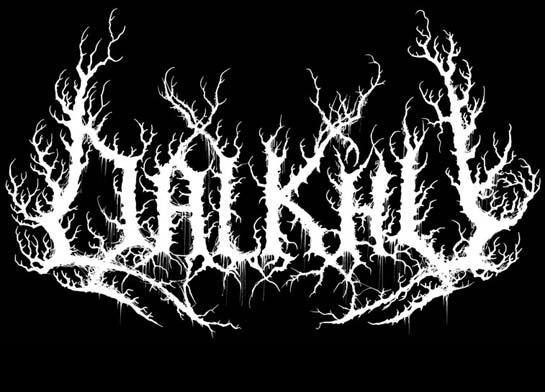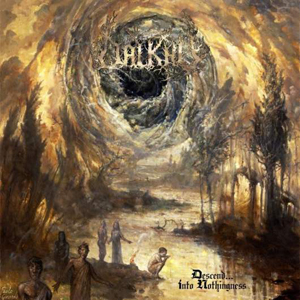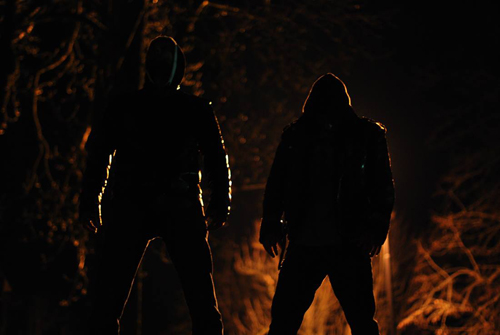
'Descend...into Nothingness'
(Satanath/Darzamadicus)

MARK: 78/100
2 camera-shy obscure-looking permanent members and a session drummer compose the line-up behind the Slovenian ensemble's comeback, which was released on CD, vinyl and tape by three different labels.
Dalkhu is a Sumerain word meaning 'evil spirits' so it's no surprise that lyricwise, the 7 tracks deal with: one's grave in a black cave, evoked anti-cosmic powers, being reborn in the woods at night, Erebus, the creator of pain, the doom caused by the soulkeepers and Maveth, the God of water and angel of death.
While the production at Nightside and Necromorbus studio is not bad even if not fat and massive enough, the artwork Dante's "Inferno"-reminescent painting comes at the hands of Paolo Girardi, known for his countless works (artworks and cover arts) for scores of bands.
Although still classified as a Black Metal act, there's not so much left of that as evinced right away from the opener "Pitch Black Cave"; some riffs have a Black Metal feel, but most of them are mid-tempos alternated with blastbeats reminding Immolation, Incantation and the likes, and what's more the new vocalist is mostly devout to guttural Death Metal and with little Black Metal in his DNA.
"The Fireborn" begins in a sinister way, then veers towards technical Death Metal rich in dissonant breaks, which a brief guitar solo is added to. Only a few arpeggios and riffs belong to Black Metal here, while the vocals keep sounding very low.
Uniting cleverly melodic guitars and vocals seeming to come from a deep abyss, "In the Woods" also incorporates several blastbeats and sporadic Black Metal riffs, still Death metal takes the lion's share. The relaxed parts are the most memorable along with the Folk Metal breakdown in the finale.
Intense Viking Metal rife with melodious structures: that's the core of the first moments of "Distant Cry", followed by guttural parts and fast blastbeats. The tremolo-picked tunes in the vein of Dissection are less depressive than the ones featured in the debut album dated 2010, while as for the tight drumming, that contrasts with the mid-tempo guitar and the Black Metal scream at the end.
Switching from dark and bulldozing Death Metal to dynamic riffs, all diverse and interesting, the Slovenians also decide to deliver a crushing riff in the style of Jungle Rot and a brief axe solo to conclude the composition titled "Accepting the Buried Signs".
"Soulkeepers" is based upon a horrorific intro reminding Death SS until the first riff created to prepare the listeners for the most Black Metal track of the batch arrives. Black Metal are the guitar and the drumwork, whereas the vocals are profoundly guttural as usual. Although the formula is being repeated, this composition stands out thanks to the marvellous elegant riffs that were put in, as well as the most effective axe solo of the album, which is divided in two fragments. Really noteworthy is the arpeggio placed before a fill-in section and brilliant twisted riffs to follow, before the main theme is reprised. Another axe solo is added at the final extremity of the piece, very full of pathos. To my view, this is the highlight of "Descend...into Nothingness".
More primitive and punishing, "E.N.N.F." also possesses some atmospherical breakdown riffs; also, there are more Viking guitars on a Death Metal texture and mid-tempo riffs avulsed from any musical genre that I know. There are other Death Metal parts and original riffs as well making Dalkhu's music unique; I'm sure that guitar players will appreciate the unusual and unexpected guitar plot present in this closing lengthy track and especially the conclusive licks, while drummers will notice that the blastbeating drum plot is easy but extremely effective at the same time.
There's really no reason to not take the time out and hear this underground gem you probably never even knew existed.

Line-up on this record:
J.G. - g., b., additional v.
P.Z. - v.
Spawn of the Void - session d.
Contacts:
Slovenj Gradec - Slovenia
E-mail: thedalkhu@gmail.com
Official sites: https://www.facebook.com/pages/Dalkhu/213754775432409
https://dalkhuofficial.bandcamp.com
Demo-/Disco-graphy:
-Ars Goetia (demo - 2006)
-Imperator (CD - 2010)
-Descend...into Nothingness (CD - 2015)
